
Rockery Stone 85#, Museum of Fine Arts Boston Collection; stainless steel, 320x220x150cm
by Liu Libin
Part VI The Spectacle of Tradition
Till now, the most familiar work of Zhan Wang’s is “Rockery Stone”. Zhan Wang, who wants to view the world as ‘round’ has to involve other aspects of reality: history and ‘tradition’ to be in tune with history.
In conclusion, there are two concentrated elements with Zhan Wang and ‘tradition’. One is the time with his grandfather, during childhood; the other is in 1981 (when Zhan was 18) he visited and sketched traditional sculptures in the museums of Shanxi and Shanxi province with his schoolmates at the art academy. One is day to day existence element, the other academic research.
Getting in touch with ‘tradition’ is just a potential ‘gene’ of Zhan’s creation. Fortune is needed to unlock it and elaborate its’ function. Apart from fortune built by meetings with friends, I believe that ‘reality’ contradicts with tradition and is a more important reason that forced Zhan Wang to consider and deal with ‘tradition’. Zhan Wang, who walks between ‘two poles’, won’t be indulged in tradition.
Rapid emergence of city (materiality) ‘public space’, the progress of ‘industrialization’ experienced by China — it’s two urgent practical problems Zhan Wang felt and tried to deal with in art. From rebuilding of a public space in “Sidewalk” to introspection to ‘industrialization’ in “94 Clean Ruins” in 1994, Zhan actually started dealing with this problem. This is a clue that can be seen, it’s inevitable for Zhan Wang to create “Rockery Stone” in 1995. Just like he said “Without the industrial revolution, we human beings would not have stepped on another stage. But the industrial revolution is not a permanent plan; it should be a temporary platform. The key is how to treat the platform. Stainless steel rockery stone deals with this question.” ——Summary of Creation Journey, 2010.
If ‘tradition’ and ‘contemporary’ are seen as poles apart, then Zhan Wang just used ‘stainless steel rockery stone’ to describe the intermediate zone by “Rockery Stone”. ‘Stone’ represents ‘tradition’, “it’s the basic element that formed the universe, representing aesthetic belief of a farming community”; ‘Stainless steel’ is a concentrated reflection of an industrialized reality. Zhan Wang thought it’s “the most representative material of this time, a metallic material that claims to never stain and can be mirror polished”. ‘Playing with’ the two materials, Zhan Wang touched the lifeline of the time.

Rockery Stone 92#, 2006; National Museum of Scotland Collection

Rockery Stone42# exhibited at Arthur M. Sackler Museum of Art and Archaeology at Peking University
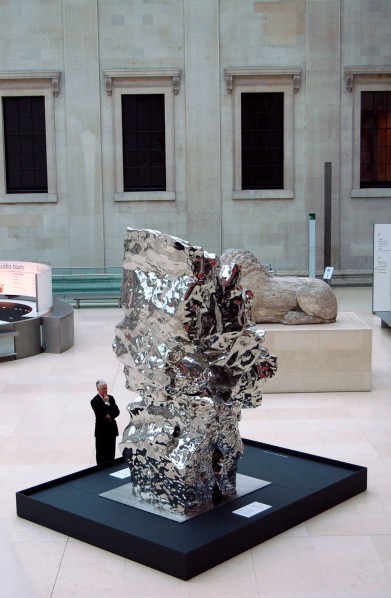
Rockery Stone (2)exhibited at British Museum in 2008
“Rockery Stone” is doubtlessly a summit of Zhan Wang’s creations and perfectly reflects his ‘conceptual sculpture’ concept. Of course if seen as an ‘evolutionism’ mode of art style, Zhan Wang’s following perfection to “Rockery Stone” didn’t contain any practical surmounting. Zhan Wang put forward two reasons: the first is a perfect thing that needs no transcendence, only perfection; the other is the finding of a creating symbol that marks the appearance of an artist while perfecting the symbol and forms a creation system to prove that his value of existence signifies his maturity.
After analysis one does not need to think more than these two reasons. What I want to analyze more is what reason caused his insistence on the progress. How did Zhan Wang perfect the creation symbol “Rockery Stone” and form his creation system?
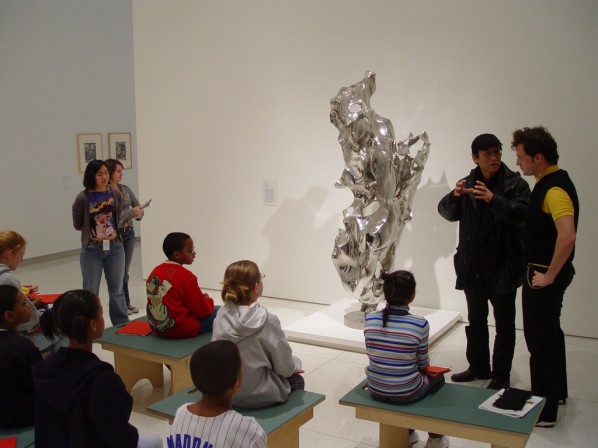
Rockery Stone at Art Museum of University of Chicago
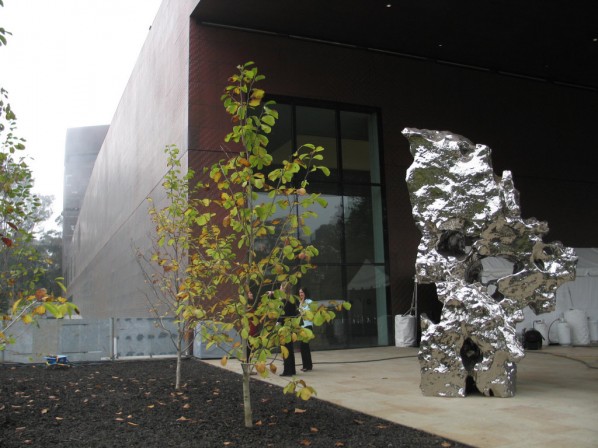
Rockery Stone, De Young Museum, San Francisco Collection
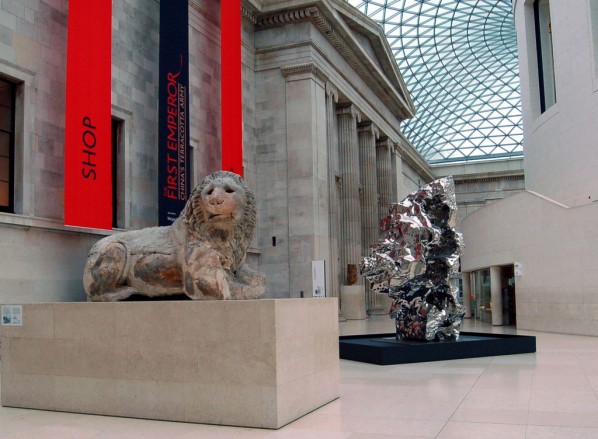
Rockery Stone exhibited at British Museum in 2008
‘Game’ attitude and ‘dream ‘complex is the major reason for Zhan to be obsessed with “Rockery Stone”. In his view, the so-called ‘doctrine of the mean’ actually contains inclusiveness, it’s a way to ‘handle a difficult task with great ease’ it meets the meaning of ‘game’. He thought a game is not a simple thing that everyone can play, the complexity of it totally compares with the complexity of society. Also it needs strict rules; otherwise it’s not a game. Maintaining such a high regulation on ideology and game playing behavior in fact maintains some kind of individuality. An artist with an individual state can construct their ‘dreaming world’. Rather than deeming it as an artist's day-dreaming, we should regard it as construction, maintaining and the persistance of an artist to his art world.
However on a subjective spiritual level, ‘gaming’ and ‘dreaming’ are still irrelevant to creation. Therefore, Zhan Wang did his ‘landscape production’ based on “Rockery Stone”. This creation expands in three directions, one is to place “Rockery Stone” in ‘fifth’ space; the second is to have real space placement of “Rockery Stone” and make it a participant of the real space (and an illusionary reality at the same time); the third one is continuation and depth based on the existing “Rockery Stone” or deconstruction.
The first kind of creation, from “Floating Stone in Open Sea” ( 2000) to “Inlaying the Great Wall” (2001 – 2003), “Mount Everest” (2004) and “Floating Mountain of Immortal” (2005), through to choosing the special unrealistic locations (such as places that general people find hard to reach such as the great wall, outer space and the open sea) Zhan Wang expanded the metaphor of the space of rockery stone and entered into a spiritual space —“It’s not a public space of general meaning, neither surrealism space (space in dreams). It’s a real space in between both. From the angle of location of the art piece, I call it the ‘fifth space’. (The first space refers to the artist’s studio, and then exhibition hall, gallery, and then the public open space, the fourth one is the private space of the collector or collecting organization.)” ——My Art Experiment Journey, 2004.
The second kind of creation, from “Urban Bonsai” (2003) to “Urban Landscape” (2003 – 2005), the original intention of the “Rockery Stone” is retired, it became a ‘symbol’ and a metaphor of the changing of real society; revealing the vanity of practical society and illusions that accompany it.
The exhibition “Garden Utopia” (solo exhibition) held at the National Art Museum of China in 2008 combined two of the above creations. The title of the exhibition echoes with Zhan Wang’s ‘gaming’ attitude and ‘dream’ complex. However he named his art world “Utopia”. The ‘Utopia’ seems to be approachable, but unreachable, just like the feelings of Chinese citizens at the time.
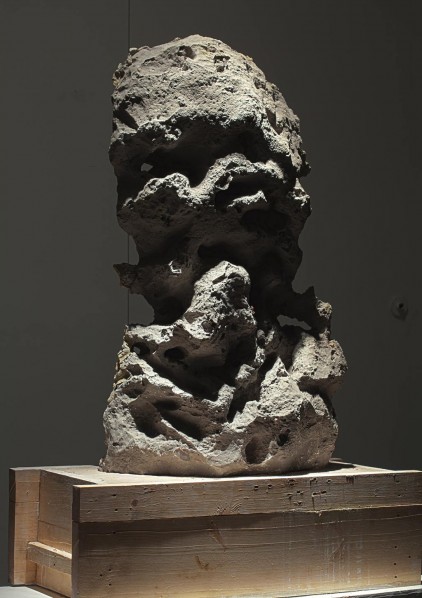
A Stone created by“Suyuan Stone Generator” (2010)
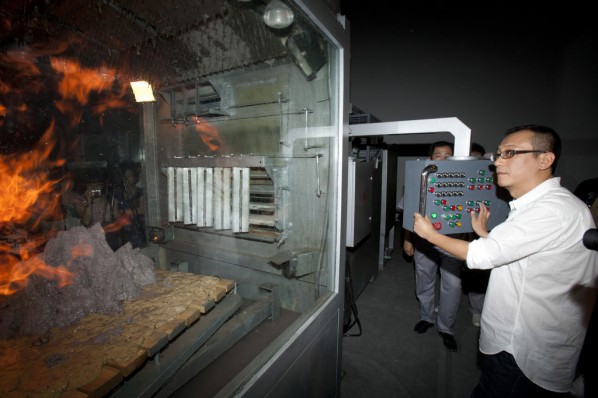
“Suyuan Stone Generator” (2010) at Today Art Museum
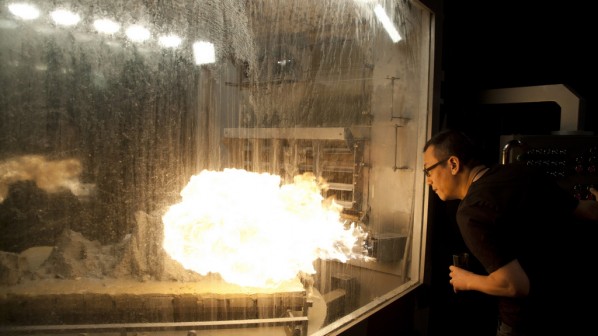
“Suyuan Stone Generator”02 (2010) at Today Art Museum
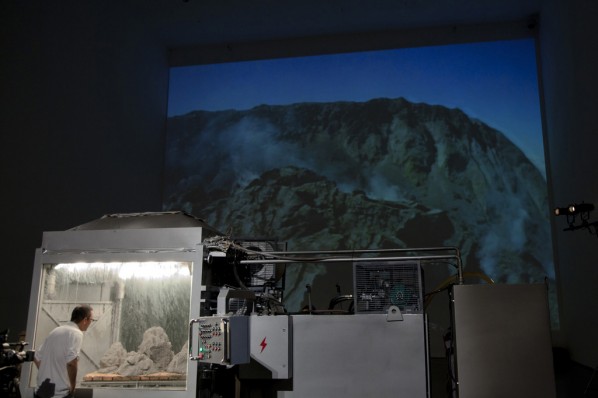
“Suyuan Stone Generator” (2010) Installation View 02 at Today Art Museum
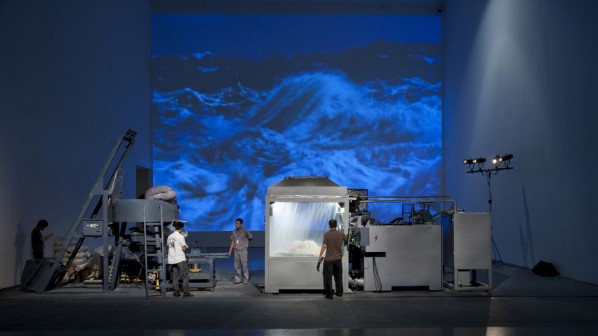
“Suyuan Stone Generator” (2010) Installation View
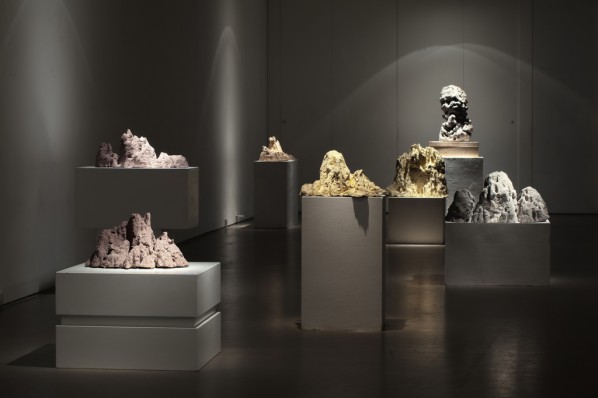
“Suyuan Stone Generator” (2010) Exhibition View
The third kind of creation includes “Suyuan Stone Generator” (2010) and “Reflection” (2011). The propaganda line of the first work “1 hour equals to 1 billion years” is an extreme compression of time by Zhan Wang. The giant machine installation at the spot, the process of a machine generating real “Rockery Stone” and the rough texture of the real “Rockery Stone”, all of the three divided ‘tradition’, ‘history’ and their various interpretations and revealed the real and brutal aspect. The latter work expanded the explosive moment of “Rockery Stone”, ‘no breaking, no setting up’ and ‘no setting up, no breaking’ is presented in soothing music from the video. In the exotic view created by light reflections, the reality is endowed with a magic skin.
Zhan Wang’s moderate gesture is presented in the two works both positively and negatively.
The End
Courtesy of Liu Libin & Image Courtesy Zhan Wang.
The views expressed in this column are the author’s own and do not represent those of CAFA ART INFO.




























